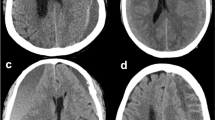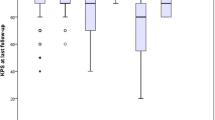Abstract
Background
Chronic subdural hematoma (CSDH) is a frequently encountered neurosurgical condition, especially in the elderly. We investigated predictive factors for surgical and functional outcomes after burr-hole drainage (BHD) surgery.
Methods
All patients with CSDH treated by BHD between January 2012 and December 2014 were included in this study. All patients were classified by symptom, clinical grade, time, location, hematoma density, midline shift, and other characteristics. Pre- and postoperative CT evaluation was performed at 0, 3, and 6 months. Clinical grades were classified as described in Markwalder et al. Surgical and clinical outcomes were evaluated with the brain expansion rate and modified Rankin Scale (mRS). Brain expansion rate was calculated as the ratio between post- and pre-operative hematoma thickness. Recurrence was defined as the occurrence of symptoms and hematoma on CT within 6 months.
Results
This study included 130 patients over 2 years. Among the variable parameters, young age (<75), iso-density of hematoma on CT, and short duration from symptom to surgery were correlated with good brain expansion. Patients with good brain expansion had fewer recurrences. In terms of mRS, young age, iso-density, and good clinical grade were correlated with good functional outcomes.
Conclusions
Clinicians should be more aware of general conditions and medical problems, especially in elderly patients. Membranectomy should be considered in patients with a long duration of symptoms or hypo-dense hematomas to promote good brain expansion and good mRS scores.
Similar content being viewed by others
References
Abouzari M, Rashidi A, Rezaii J, Esfandiari K, Asadollahi M, Aleali H, Abdollahzadeh M (2007) The role of postoperative patient posture in the recurrence of traumatic chronic subdural hematoma after burr-hole surgery. Neurosurgery 61:794–797, discussion 797
Baechli H, Nordmann A, Bucher HC, Gratzl O (2004) Demographics and prevalent risk factors of chronic subdural haematoma: results of a large single-center cohort study. Neurosurg Rev 27:263–266
Chen JC, Levy ML (2000) Causes, epidemiology, and risk factors of chronic subdural hematoma. Neurosurg Clin N Am 11:399–406
Ernestus RI, Beldzinski P, Lanfermann H, Klug N (1997) Chronic subdural hematoma: surgical treatment and outcome in 104 patients. Surg Neurol 48:220–225
Gelabert-Gonzalez M, Iglesias-Pais M, Garcia-Allut A, Martinez-Rumbo R (2005) Chronic subdural haematoma: surgical treatment and outcome in 1000 cases. Clin Neurol Neurosurg 107:223–229
Hamilton MG, Frizzell JB, Tranmer BI (1993) Chronic subdural hematoma: the role for craniotomy reevaluated. Neurosurgery 33:67–72
Hong HJ, Kim YJ, Yi HJ, Ko Y, Oh SJ, Kim JM (2009) Role of angiogenic growth factors and inflammatory cytokine on recurrence of chronic subdural hematoma. Surg Neurol 71:161–165, discussion 165-166
Ito H, Komai T, Yamamoto S (1978) Fibrinolytic enzyme in the lining walls of chronic subdural hematoma. J Neurosurg 48:197–200
Ito H, Yamamoto S, Komai T, Mizukoshi H (1976) Role of local hyperfibrinolysis in the etiology of chronic subdural hematoma. J Neurosurg 45:26–31
Javadi A, Amirjamshidi A, Aran S, Hosseini SH (2011) A randomized controlled trial comparing the outcome of burr-hole irrigation with and without drainage in the treatment of chronic subdural hematoma: a preliminary report. World Neurosurg 75:731–736, discussion 620-733
Kayaci S, Kanat A, Koksal V, Ozdemir B (2014) Effect of inner membrane tearing in the treatment of adult chronic subdural hematoma: a comparative study. Neurol Med Chir (Tokyo) 54:363–373
Killeffer JA, Killeffer FA, Schochet SS (2000) The outer neomembrane of chronic subdural hematoma. Neurosurg Clin N Am 11:407–412
Ko BS, Lee JK, Seo BR, Moon SJ, Kim JH, Kim SH (2008) Clinical analysis of risk factors related to recurrent chronic subdural hematoma. J Korean Neurosurg Soc 43:11–15
Koivisto T, Jaaskelainen JE (2009) Chronic subdural haematoma—to drain or not to drain? Lancet 374:1040–1041
Kostanian V, Choi JC, Liker MA, Go JL, Zee CS (2000) Computed tomographic characteristics of chronic subdural hematomas. Neurosurg Clin N Am 11:479–489
Kristof RA, Grimm JM, Stoffel-Wagner B (2008) Cerebrospinal fluid leakage into the subdural space: possible influence on the pathogenesis and recurrence frequency of chronic subdural hematoma and subdural hygroma. J Neurosurg 108:275–280
Kudo H, Kuwamura K, Izawa I, Sawa H, Tamaki N (1992) Chronic subdural hematoma in elderly people: present status on Awaji Island and epidemiological prospect. Neurol Med Chir (Tokyo) 32:207–209
Kusano Y, Horiuchi T, Seguchi T, Kakizawa Y, Tanaka Y, Hongo K (2010) Local brain herniation after partial membranectomy for organized chronic subdural hematoma in an adult patient: case report and review of the literature. Brain Inj 24:1118–1121
Kwon TH, Park YK, Lim DJ, Cho TH, Chung YG, Chung HS, Suh JK (2000) Chronic subdural hematoma: evaluation of the clinical significance of postoperative drainage volume. J Neurosurg 93:796–799
Labadie EL, Glover D (1974) Chronic subdural hematoma: concepts of physiopathogenesis. A review. Can J Neurol Sci 1:222–225
Lind CR, Lind CJ, Mee EW (2003) Reduction in the number of repeated operations for the treatment of subacute and chronic subdural hematomas by placement of subdural drains. J Neurosurg 99:44–46
Markwalder TM (2000) The course of chronic subdural hematomas after burr-hole craniostomy with and without closed-system drainage. Neurosurg Clin N Am 11:541–546
Mori K, Maeda M (2001) Surgical treatment of chronic subdural hematoma in 500 consecutive cases: clinical characteristics, surgical outcome, complications, and recurrence rate. Neurol Med Chir (Tokyo) 41:371–381
Richter HP, Klein HJ, Schafer M (1984) Chronic subdural haematomas treated by enlarged burr-hole craniotomy and closed system drainage. Retrospective study of 120 patients. Acta Neurochir (Wien) 71:179–188
Robinson RG (1984) Chronic subdural hematoma: surgical management in 133 patients. J Neurosurg 61:263–268
Singh AK, Suryanarayanan B, Choudhary A, Prasad A, Singh S, Gupta LN (2014) A prospective randomized study of use of drain versus no drain after burr-hole evacuation of chronic subdural hematoma. Neurol India 62:169–174
Yamashima T (2000) The inner membrane of chronic subdural hematomas: pathology and pathophysiology. Neurosurg Clin N Am 11:413–424
Author information
Authors and Affiliations
Corresponding author
Ethics declarations
Funding
No funding was received for this research.
Conflict of interest
All authors certify that they have no affiliations with or involvement in any organization or entity with any financial interest (such as honoraria; educational grants; participation in speakers’ bureaus; membership, employment, consultancies, stock ownership, or other equity interest; and expert testimony or patent-licensing arrangements), or non-financial interest (such as personal or professional relationships, affiliations, knowledge or beliefs) in the subject matter or materials discussed in this manuscript.
Ethical approval
All procedures performed in studies involving human participants were in accordance with the ethical standards of the institutional and/or national research committee and with the 1964 Helsinki Declaration and its later amendments or comparable ethical standards. For this type of study, formal consent is not required.
Rights and permissions
About this article
Cite this article
Ro, H.W., Park, S.K., Jang, D.K. et al. Preoperative predictive factors for surgical and functional outcomes in chronic subdural hematoma. Acta Neurochir 158, 135–139 (2016). https://doi.org/10.1007/s00701-015-2625-z
Received:
Accepted:
Published:
Issue Date:
DOI: https://doi.org/10.1007/s00701-015-2625-z




